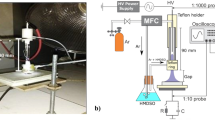Abstract
Effect of solution concentration on the structures and corrosion inhibition behavior of γ-APS films fabricated on surface of low carbon steel was systematically studied by EIS, RA-IR, and AFM. The experimental results indicated that the impedance of γ-APS silane treated substrates and the cross-linking degree of γ-APS films gradually increased with the increasing solution concentration. There was some noticeable transformation in molecular orientation and protective performance of γ-APS films when solution concentration was above 10vol%. High cross-linking degree and changes in molecular orientation generated γ-APS films with excellent protective performance and ordered arrangement.
Similar content being viewed by others
References
Yang LX, Liu MX, Lei XL, et al. Study on the Adsorption Behavior of γ-GPS on Low Carbon Steel Surfaces Using RA-IR, EIS and AFM[J]. Appl. Surf. Sci., 2011, 257(23):9 895–9 903
Flis J, Kanoza M. Electrochemical and Surface Analytical Study of Vinyl-triethoxy Silane Films on Iron after Exposure to Air[J]. Electrochim. Acta, 2006, 51(11):2 338–2 345
Wu LQ, Zhang JT, Hu JM, et al. Improved Corrosion Performance of Electrophoretic Coatings by Silane Addition[J]. Corros. Sci., 2012,56:58–66
Yang LX, Feng J, Zhang WG, et al. Film Forming Kinetics and Reaction Mechanism of γ-glycidoxypropyltrimethoxysilane on Low Carbon Steel Surfaces[J]. Appl. Surf. Sci., 2010,256(22): 6 787–6 784
Boerio FJ, Williams JW. Structure and Properties of Organosilane Primers for Adhesive Bonding[J]. Appl. Surf. Sci., 1981,7(1–2):19–31
Ishida H, Chiang C, Koenig JL. The Structure of Aminofunctional Silane Coupling Agents: 1. γ-Aminopropyltriethoxysilane and Its Analogues[J]. Polymer, 1982,23(2):251–257
Quinton JS, Dastoor PC. Conformational Dynamics of γ-APS on the Iron Oxide Surface: An Adsorption Kinetic Study Using XPS and ToFSIMS[J]. Surf. Interface Anal., 2000, 30(1):21–24
Watts B, Thomsen L, Fabien JR. Understanding the Conformational Dynamics of Organosilanes: γ-APS on Zinc Oxide Surfaces[J]. Langmuir, 2002,18(1):148–154
Thomsen L, Watts B, Dastoor PC. A NEXAFS Orientation Study of γ-aminopropyltriethoxysilane on Zinc Oxide Surfaces[J]. Surf. Interface Anal., 2006,38(7): 1 139–1 145
Culler SR, Ishida H, Koenig JL. Structure of Silane Coupling Agents Adsorbed on Silicon Powder[J]. J. Colloid Interface Sci., 1985, 106(2):334–346
Chico B, Galvan JC, Fuente D de la, et al. Electrochemical Impedance Spectroscopy Study of the Effect of Curing Time on the Early Barrier Properties of Silane Systems Applied on Steel Substrates[J]. Prog. Org. Coat., 2007,60(1): 45–53
Chen JS Diard, JP Durand R, et al. Hydrogen Insertion Reaction with Restricted Diffusion. Part 1. Potential step-EIS Theory and Review for the Direct Insertion Mechanism[J]. J. Electroanal.Chem., 1996,406(1–2): 1–13
WJ van Ooij, Zhu D. Electrochemical Impedance Spectroscopy of Bis-[triethoxysilypropyl]tetrasulfide on Al 2024-T3 Substrates[J]. Corrosion, 2001,57(5): 413–427
Kanoza M, Flis-kabulska I, Flis J. Effect of Aging in Air and Immersion into Phosphate Solution on Protectiveness and Transformations of Vinyltriethoxy Silane Nanofilms on Iron[J]. Corros. Sci., 2012, 61: 224–230
Zucchi F, Frignani A, Grassi V, et al. The Formation of a Protective Layer of 3-mercapto-propyl-trimethoxy-silane on Copper[J]. Corros. Sci., 2007,49(3): 1 570–1 583
Behzadnasab M, Mirabedini SM, Kabiri K, et al. Corrosion Performance of Epoxy Coatings Containing Silane Treated ZrO2 Nanoparticles on Mild Steel in 3.5% NaCl Solution[J]. Corros. Sci., 2011,53(1): 89–98
Trabelsi W, Cecilio P, Ferreira MGS, et al. Electrochemical assessment of the Self-healing Properties of Ce-doped Sianle Solutions for the Pretreatment of Galvanized Steel Substrates[J]. Prog. Org. Coat., 2005, 54: 276–284
Trabelsi W, Dhouibi L, Triki E, et al. An Electrochemical and Analytical Assessment on the Early Corrosion Behaviour of Galvanised Steel Pretreated with Aminosilanes[J]. Surf. Coat. Technol., 2005, 192(2–3): 284–290
Trabelsi W, Triki E, Dhouibi L, et al. The Use of Pre-treatments Based on Doped Silane Solutions for Improved Corrosion Resistance of Galvanised Steel Substrates[J]. Surf. Coat. Technol., 2006,200(14–15): 4 240–4 250
Franquet A, Le Pen C, Terryn H, et al. Effect of Bath Concentration and Curing Time on the Structure of Non-functional Thin Organosilane Layers on Aluminium[J]. Electrochim. Acta, 2003,48(9):1 245–1 255
Zhu DQ, WJ van Ooij. Corrosion Protection of AA 2024-T3 by Bis-[3-(triethoxysilyl)propyl]tetrasulfide in Sodium Chloride Solution Part 2: Mechanism for Corrosion Protection[J]. Corros. Sci., 2003,45(10): 2 177–2 197
Bonora PL, Deflorian F, Fedrizzi L. Electrochemical Impedance Spectroscopy as a Tool for Investigating Underpaint Corrosion[J]. Electrochim. Acta, 1996,41(7–8):1 073–1 082
Chiang CH, Ishida H, Koenig JL. The Structure of Aminopropyltriet hoXysilane on Glass Surface[J]. J.Colloid Interface Sci., 1980,74(2): 396–404
Roche V, Perrin FX, Gigmes D, et al. Tracking the Fate of Gammaaminopropyltriethoxysilane from the Sol State to the Dried Film State[J]. Thin Solid Films, 2010, 518(14):3 640–3 645
Yuan W, WJ van Ooij. Characterization of Organofunctional Silane Films on Zinc Substrates[J]. J.Colloid Interface Sci., 1997,185(1): 197–209
Kurth DG, Bein T. Thin-films of (3-aminopropyl)triethoxysilane on Aluminum-oxide and Gold Substrates[J]. Langmuir, 1995, 11(8): 3 061–3 067
Quinton JS, Dastoor PC. Modelling the Observed Oscillations in the Adsorption Kinetics of Propyltrimethoxysilane on Iron and Aluminium Oxide Surfaces[J]. Surf. Interface Anal., 2000,30(1):25–28
Quinton JS, Dastoor PC. Adsorption of Organosilanes on Iron and Aluminium Oxide Surfaces[J]. Surf. Interface Anal., 1997, 25(12): 931–936
Moreno EM, Zayat M, Morales MP, et al. Preparation of Narrow Size Distribution Superparamagnetic γ-Fe2O3 Nanoparticles in a Sol-gel Transparent SiO2 Matrix[J]. Langmuir, 2002,18(12):4 972–4 978
Huang XH, Chen ZH. Preparation and Characterization of CoFe2O4/SiO2 Nanocomposites[J]. Chin. Sci. Bull., 2006,51(20):2 529–2 534
Author information
Authors and Affiliations
Corresponding author
Additional information
Funded by the National Natural Science Foundation of China (No.50801057) and the Special Fund for Basic Scientific Research of Central Colleges, China University of Geosciences (Wuhan) (No. 007-G1323521109)
Rights and permissions
About this article
Cite this article
Yang, L., Zhang, Y., Lei, X. et al. Effect of solution concentration on the structures and corrosion inhibition behavior of γ-APS films fabricated on surface of low carbon steel. J. Wuhan Univ. Technol.-Mat. Sci. Edit. 28, 224–230 (2013). https://doi.org/10.1007/s11595-013-0669-6
Received:
Accepted:
Published:
Issue Date:
DOI: https://doi.org/10.1007/s11595-013-0669-6




